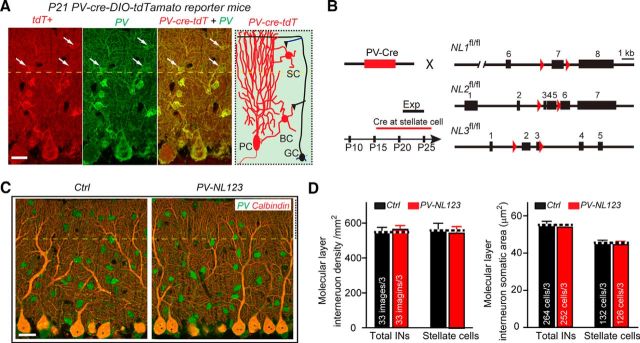Figure 1.
PV-Cre-mediated conditional KO of NL123 does not alter the overall morphology of the cerebellar cortex or of cerebellar stellate cells. A, Single focal plane showing triple immunostaining tdTomato (red fluorescence), parvalbumin (Pv, green fluorescence), and calbindin (Cal, purple fluorescence) of the cerebellum. Data are from a 21-day-old tdTomato-Cre-reporter mouse crossed with PV-Cre transgenic mice. For the current study, the interneurons in the upper third territory of the molecular layer (above dashed line) were classified as stellate cells; cells expressing both Pv and tdTomato appear yellow. Note the robust Cre activity in Pv-positive stellate cells, even though Cre activity is higher in basket cells. B, Illustration of the breeding strategy for conditional ablation of neuroligins in PV-expressing neurons of the cerebellum. PV-Cre mice were crossed with NL123 triple cKO mice; littermate NL123 triple cKO mice lacking PV-Cre were used as controls. C, Single focal plane showing parvalbumin (green fluorescence) and calbindin (red fluorescence) double immunostaining of the cerebellum in control and PV-Cre-NL123 cKO mice. D, Summary data of cell density and soma size of control and neuroligin-deficient interneurons in the molecular layer of the cerebellum. Data are means ± SEM. Numbers in bars represent the number of slices (or cells)/number of mice used. Statistical significance was determined by Student's t test.

